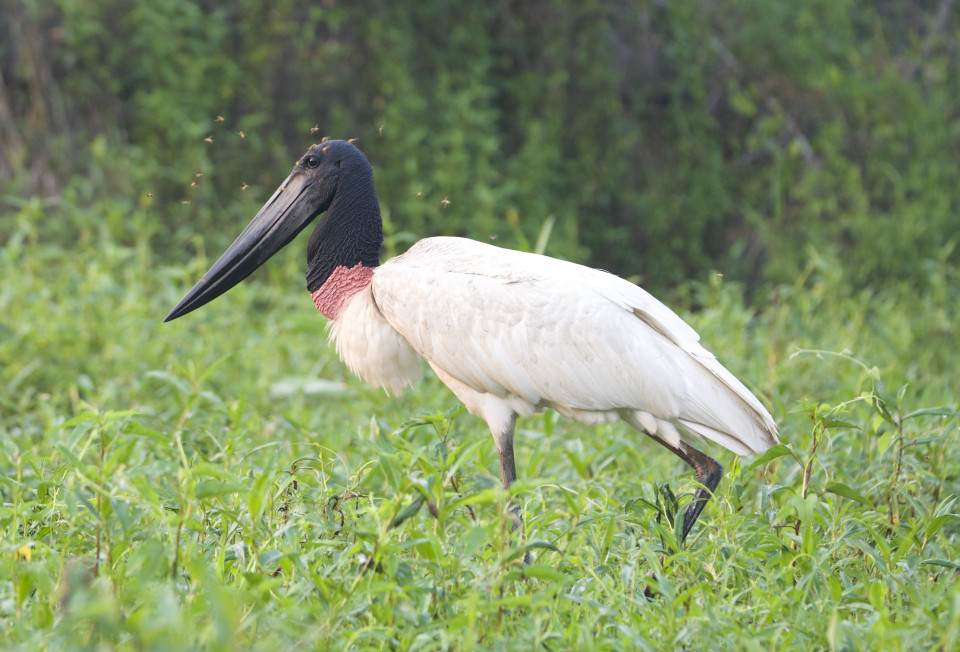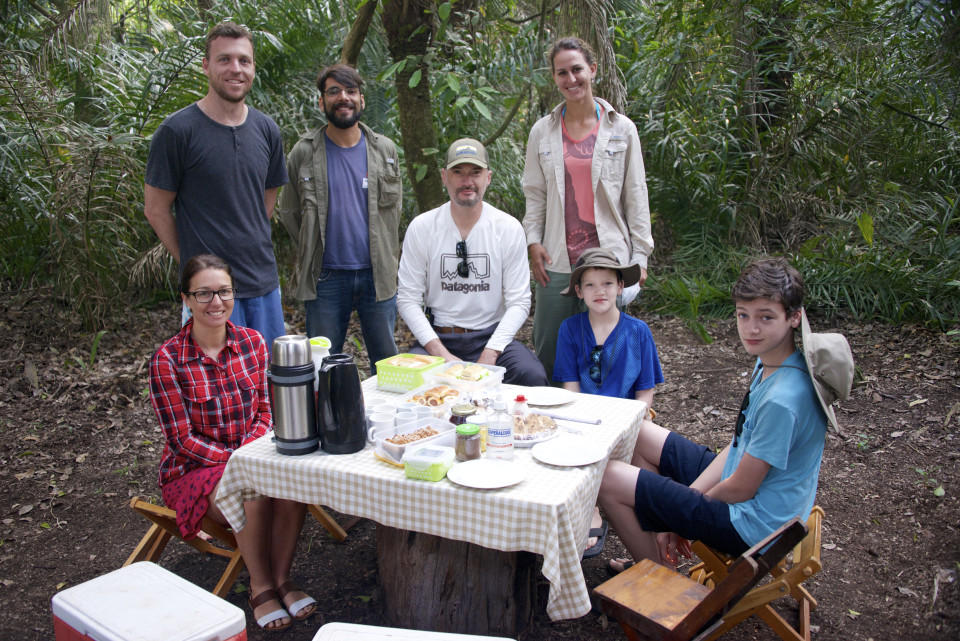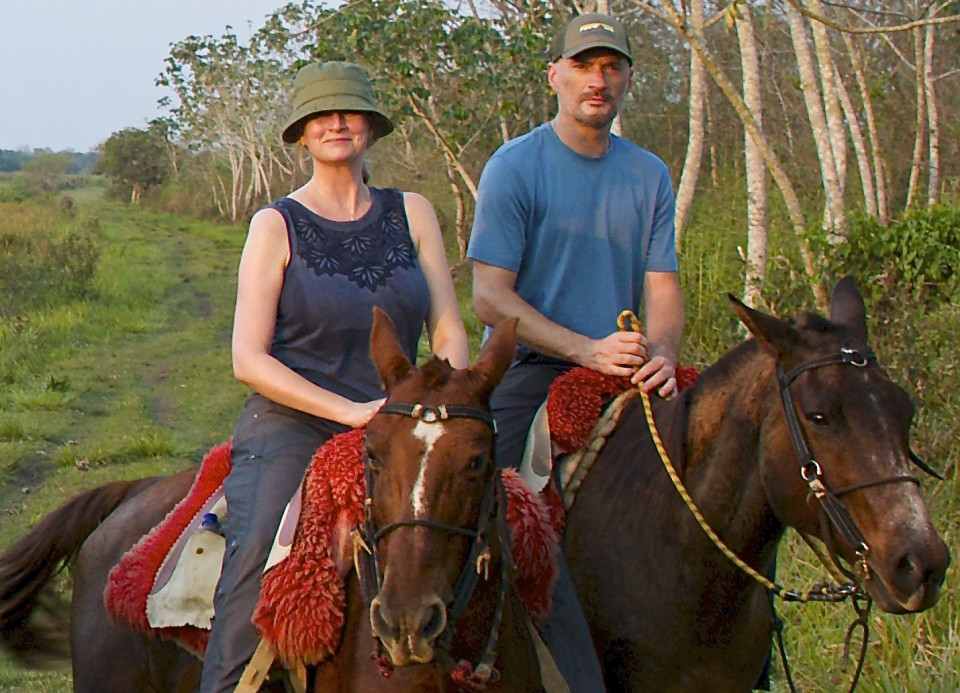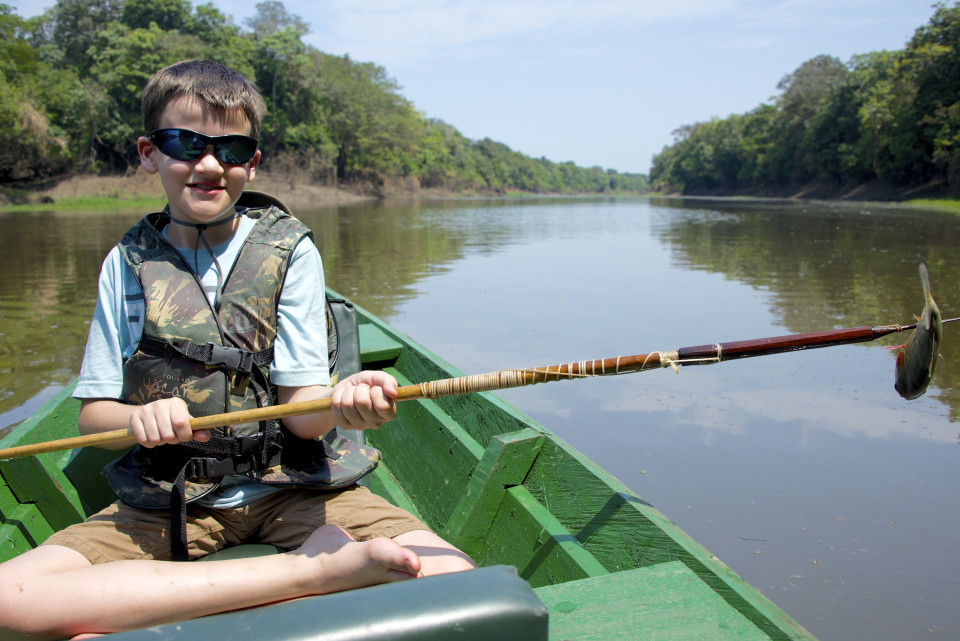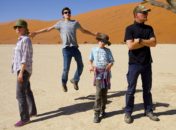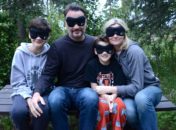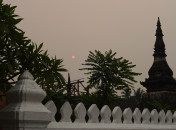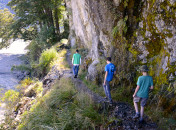Asher and I were standing at the end of a three-meter long tree stump that was stretched out over the fastest part of the Salobra River. We were nervous.
Beneath us, schools of fish hovered in the shadow of our jungle diving board and large patches of breakaway lilies floated by. The water was clear enough to see the rocks and sand laying at the bottom of the deep channel.
The river moved swiftly by the camp, past a rickety deck, under the bridge and out into the wild delta beyond. A pair of orange life rings strung on a nylon rope drifted at the surface of the water downstream and were our only safety if we missed grabbing the deck. All we needed to do was jump to find relief from the balmy afternoon. But we hesitated.
I asked our guide Manoela if there was anything we needed to know before jumping. Any dangers?
“No. You don’t have to worry about the Caiman or the piranha. They’re not as aggressive as in the Amazon. Just watch where you step in the sand because the sting rays are venomous, and they’re hard to see.”
She added, “but don’t miss the deck or you’ll be carried under the bridge. I’ll have to get the canoe to find you.” Apparently, we learned later, there’s a territorial male river otter just past the bridge who might not have welcomed our presence.
“You still want to do this, Dad?” Asher asked. Before I could answer, his face blanched and he turned back to Mano. “What about anaconda? Do you see them much?”
“Of course,” she replied.
Asher looked at me. I looked back at him, and then we jumped together.
PICK YOUR DANGER
Murder. Yellow Fever. Kidnapping. HIV/AIDS. Favelas. Piranha. Caipirinha. Dengue. Arguably, Brazil is a living actuarial table. Danger abounds in the cities and the jungles; it lurks in the water and buzzes around exposed skin. Check the internet and you’ll find plenty of reasons to find alternative destinations – “21 of Top 50 Most Dangerous Cities Found in Brazil” or “Zika Threats Rattle Global Disease Experts.”
Before we left the U.S., we endured a fusillade of vaccinations and loaded up with three months worth of anti-malarial meds. We also abandoned most of our computer equipment and locked up our jewelry in the bank – really anything we couldn’t we couldn’t bear to lose. Just in case. We’d worked to become smart but not scared travelers, and after all, every country has it’s own unique brand of menace. In Vietnam it is motorbikes. Iceland has volcanoes, and Australia has spiders, snakes and jellyfish. Plus, if everyone judged the US by the media coverage of our gun violence, no foreigners would ever experience the joys of New York or San Francisco.
Brazil is one of the most difficult countries from which to get a travel visa, as if they want you to make absolutely sure you wante to come.
In most cases with our travels, we came to discover that fears or warnings were overwrought. In our experience of Brazil, they were real—and persistent. So, we were vigilant: we made thoughtful decisions about where we went, considered the time of day or night we were out, and held onto our bags carefully. In essence, we became wary tourists—a mode we’d worked to distance ourselves from. Despite the threats and the potential for harm, we found the people of Brazil so warm and open that we made new friends everywhere we visited. And anyone skipping Brazil because of the headlines is missing one of the world’s greatest adventures.
FIRST IMPRESSIONS
We arrived mid-morning on Tuesday, September 15, landing at Rio de Janeiro International Airport. For a city famous for wild abandon, nightlife debauchery and overindulgence, arriving in the middle of a workweek made for a muted introduction. Our taxi driver took a scenic route through the city to our apartment. Whether to pad the meter or to show off his home city, we didn’t care. We were exhausted from the 16-hour journey.
Old men sat on benches casting seed to the birds. Young people flirted and japed under the shade trees. Parents and small children held hands crossing streets flowing with noisy motorbikes and cars. Rio is like any other major city. But the normalcy of day-to-day life is punctuated by surprises as well. Simply rounding a corner might reveal the towering peaks of the mountains or a cadre of military officers guarding a black Mercedes in front of a fancy hotel.
Color is everywhere in this city of six million. Street art abounds, reflecting Brazil’s multicultural identity, and the hues of African, European and indigenous peoples’ illuminate the culture from within. Abandoned buildings are canvases, trash cans and sign posts are tagged. Murals coat bridge underpasses, telling stories of strife and ambition. Each community reflects its own brand, a love of surfing or jazz or carnival, told in aerosol and pigment.
THE URBAN GREAT BARRIER REEF
“Falas ingles?” I asked the taxi driver after we’d settled into the car.
“Where are you from?” he replied, which started a mostly one-sided conversation detailing what he loved most about America: muscle cars, and movies and TV shows about muscle cars. “You know the Gas Monkey? Fast and Furious? Mopar? Hemi? Vin Diesel is a bad ass.” As a lover of classic American cars, I connected with him. We talked and bonded while a world of ramshackle apartments stacked atop thin concrete posts and districts filled with funky and ultra-stylish shops and restaurants passed by outside.
By the time we stopped at a small car park at the foot of Corcovado, our driver had given me his mobile number, coached us on how to stay safe in Rio and offered to be our personal driver for the duration of our visit. “Let me help your visit,” he said.
We’d arrived at the base station for Cristo Redentor (Christ the Redeemer), one of the most famous symbols of Rio and the country of Brazil. A concrete and soapstone statue that stands 98 feet tall atop the Corcovado Mountain’s 2300-foot peak, the viewing platform was thronged with tourists and locals, so finding an open position along the balustrade was an exercise in patience and assertiveness.
Pushing through the crowd, we were rewarded with a panoramic view of the Tijuca Forest National Park, the Baía de Guanabara (Guanabara Bay) and Pão de Açúcar (Sugarloaf Mountain) off in the distance. From this height, peering through the fog of humidity into the depths of the city below, Rio is an urban Great Barrier Reef. The afternoon was exceptionally hot, blanketed by the haze of moisture rising from the sea and city and surrounded by elbow-to-elbow tourists who fanned themselves with guidebooks to stay cool. The only shade was in the shadow of Christ.
By the time we boarded the first of two cable cars to reach the peak of Pão de Açúcar, it was late afternoon. Although we hadn’t planned our day to catch the sunset, we timed it perfectly.
The first cable car rises from sea level to 220m to Morro da Urca. Here we paused and walked around, finding a little café that served Cokes and waters to replenish ourselves. We were plenty thirsty, having sweated out the long excursion at Cristo Redentor.
The second car rose to the full height of Pão de Açúcar at nearly 400m, where we lost ourselves in reverie. Simply staring back at the city, with the copper sun slowly settling in for the night behind the hazy mountains.
Rio is painfully gorgeous.
That evening, we walked around Leblon, our temporary home district and found Quadrucci, a Brazilian-influenced Italian eatery. Occasionally, restaurants make a memorable experience for us. This was one we’d remember for a long time. After traipsing through Rio for a day, we ordered drinks, played cards and enjoyed one of the best meals of all our travels. The lasanha de cordeiro, lasagna with lamb, red wine and goat cheese, was incredible. Ask Ronan for a list of his favorite meals in the world, and you’ll hear about this one.
CITY TO WETLANDS
National Geographic calls the Pantanal Brazil’s best kept secret, and Lonely Planet says it’s better for animal sightings than the Amazon. Estimated at around 81,000 square miles, it is the world’s largest tropical wetland area, consisting of a patchwork of both protected and private lands. It is also a UNESCO World Heritage site.
But the journey to the Pantanal was rough going from the moment we stepped off the plane in Campo Grande. We’d started early in Rio de Janeiro and were exhausted from an early departure and a layover in Sao Paulo, and now we walked across the tarmac to passport control in humid 98 degree heat. Ahead of us lay a four-hour drive to our pousada in the heart of the Pantanal.
Our guide for the week, Manoela—Manu for short—told us that the air conditioning in the van wasn’t working, and that we’d either have to either wait three hours for a new van, or travel in this one with the windows all the way down. She seemed flexible about the windows, but I suspect was hoping we wouldn’t be. The driver, a man with thick black sideburns and sweat-stained oxford shirt, nodded at us and looked at Manu for direction.
“Which would you prefer?” she asked.
We have a tradition in our family to let the birthday girl or boy choose what we do. Usually, the decisions are centered around where we eat dinner or whether we go to a movie. Since it was Angela’s birthday and this was the only choice in front of us, she choose to suffer through heat and the battering wind of open windows to reach our destination.
INTRODUCTION TO THE PANTANAL
The Pantanal is a fisherman’s paradise, and though much of it is protected, there are lots of places where folks can fish to feed their families. At the mid-point of the route to the pousada, we pulled off at a café & bait shop. Not usually an ideal combination for a business, it smelled like a pet store inside the café, but we didn’t care. Asher wandered the store looking into the large tanks filled with live. The owner came over and said something to him in Portuguese and offered a warm smile, to which Asher replied, “I’m sorry, I don’t understand.”
It was late afternoon when we arrived at the entrance road to Refugio Da Ilha where we’d be staying for the next five nights. The dirt access road took us across a broad open tropical savanna, and Manu pointed out and named the many different kinds of birds we saw during that last bumpy ten miles or so to reach the ranch house. There’s an estimated 350 species of birds in the Pantanal and during our time there, we must have seen half of them.
As the blue gray silhouette of the jungle slowly rose at the horizon, a giant anteater loped across the road ahead of us. Even from a distance, we could see it’s fur was coarse, black and gray, four to five feet in length with a long snout and a long brush of a tail.
Manu said something urgent in Portuguese and pointed at a spot under a thorn tree. The driver pivoted off the road and across the bumpy terrain like his passenger van had the ground clearance, coil springs and locking rear differentials of a professional grade Jeep. It rattled and leaned, but somehow held together.
“If you stay close to the van, you can take a picture,” said Manu.
But all our gear was packed in the back of the van, so we didn’t have time to break out the cameras. We assumed that there’d be another opportunity, but sadly this was the one and only close encounter we’d have with the shy and elusive creature.
DAYPARTING TO MANAGE THE HEAT
The pousada sat dead center of a vast government concession that allowed our hosts only to conduct limited grazing of cattle and offer tours within their roughly 8,000 acres. Contrails were rare and no traffic noise penetrated the lush jungle. At night, the moon and stars shone brilliantly, obstructed only by the dispersion of mist as the thick forest exhaled across the cool waters of the Salobra river. We were away from everything noisy and bright and urgent.
Having spent the better part of our previous few days in Rio surrounded by city – we were thrilled to be back in the wild.
Daily outings were split into three parts – a pre-dawn part that involved fumbling around in the hazy dark, patting down the suitcase in search of clothes that felt reasonably dry; a late afternoon-to-dusk part which was a virtual fist fight with dehydration while traipsing through the fiery heat; a mid-day siesta part where we found respite in our room as the small A/C wheezed coolish air. It was this mid-day part that Asher and I typically made our way to the river to swim; hot and grumpy with a desire to sit silently while the cold water rinsed our minds clean of unnecessary noise.
BIRDWATCHING AND TEMPTING FATE
A lot of our time in boats and canoes was spent photographing birds which are easy to find in the Pantanal. We saw a pair of the elusive hyacinth macaws at dusk one day, dozens of toucans who always seemed to take flight as the camera focused, the crest-headed kingfishers, the proud and regal caracara and savanna hawks, hundreds of ibis, heron and storks, and a “herd” of the South American ostrich doppelganger, the rhea.
In the deepest parts of the river, we frequently found a solitary “old man,” the jabiru high-stepping across the tops of the thick lily mats as he hunted for small fish. Even from a distance, we could see the dark cloud of mosquitoes buzzing around the black featherless head of the stork.
Nestled in the hull of a three-meter aluminum boat with a sketchy motor that petered out often made birdwatching feel more dangerous than it should. Abandoned to the drift of the river – we pirouetted in slow motion off the banks and under the drooping branches. We experienced spider webs face-first as they wrapped our heads, ear-to-ear in silk. Very quickly we learned to press ourselves low to the hull of the boat while Manu worked to re-start the motor.
HUNTING ANACONDA
After lunch one afternoon, we were floating in the river when Manoela came up around the back side of the inn and asked, “Asher. Would you like to see an anaconda?” Since we were up to our necks in the river, I had a brief panic. When Manu waved for us to follow her, we popped out of the river immediately. “Over here!”
Behind the kitchen, the staff had created a compost heap that attracted birds. The anaconda, in this case, a small six foot juvenile had discovered patience and camouflage made the compost an ideal hunting spot. The snake had the head of a large cowbird in its mouth and was coiling to squeeze the prey when the bird wings flapped once more and stopped. Rather than eat the bird in front of a crowd aghast, it dragged the bird into the jungle and disappeared.
FLOATING AMONG STING RAYS & PIRANHA
Morning fog burns off in patches in the Pantanal We’d slowly paddle through a cooler haze only to round a tight bend in the river and be greeted with a clear sky and oven heat. Beneath us, we could see the stingrays (officially: potamotrygon pantanensis) and occasionally a small school of piranha. Colorful birds propped on tall, thin grasses.
As we canoed downstream through an area with high banks and past wooden shacks. The air was hazy smell of food cooking on open fires wafted across the river. It was the smell of fish and creosote. Children stared. Occasionally we received a smile or a wave. One late morning, we saw a group capybara sipping water and resting in the shade, wary of us as we floated by.
WATCHING GATORS WATCHING US
Occasionally, we’d pass through a clump of river flotsam, a pair of hazel reptilian eyes would surface and the shape of a large Caiman would emerge piece by piece – first the eyes; then the tail; finally the great row of teeth. It is a horrifying way to discover a predator and one that we kept in our minds as we motored or canoed or swam in the waters.
That’s right … “as we swam in the waters.” Despite the risks, Asher and I couldn’t resist the cool temptation of the water. We swam the river near the pousada. We swam downstream from a family of giant otters. And we swam in the Black Lake – a large body of black water, so dense and opaque that we couldn’t see our hands only six inches beneath the surface. We couldn’t touch the bottom of the lake. And we could see large caiman off along the shoreline. It is the stuff of nightmares, yet Asher and I found the water alluring. For fifteen minutes, we swam and floated while stringy river plants grabbed and tangled in our legs. Then your mind starts running the numbers. You begin calculating your own probabilities. And you think, maybe it’s time to get back in the boat.
CAREFULLY AVOIDING KILLER BEES
It was on horseback late one afternoon that a missed trail brought Asher and I by an enormous hive of killer bees; not once, or twice, but three times we had to keep the horses calm and quiet as we threaded the needle between the barbed wire fence and the hollowed log where the bees lived. It was on this same excursion, we came face-to-face with a male Rhea defending it’s nest – barking a warning at us.
The river otters were typically found hidden among the river flora or floating in the backchannels where a large four foot long mammal that looks a little like a sleek black bear is thrilling to see.
Patches of lilies floated by as kingfishers swooped a hair off the surface beaking unsuspecting insects.
ARGUING WITH POACHERS
We were in protected land, so we were surprised to find a couple of grizzled men sitting in a short wooden boat. Our guide Manu was angry, “excuse me,” she said to us before speaking in Portuguese to the men. At first, the words were softly spoken, but when one of the men shook his head and rebaited a hook, her tone took on a harder edge. Finally, Manu steered our boat up close to the men and she snapped a picture of their faces. They seemed unaffected.
Someone famous once said that nothing great is accomplished without first passing through danger. It was with that in mind that we embarked on the last leg of our Brazilian journey.
THE SCARIEST, MOST DANGEROUS THIRTY MINUTES OF OUR TRAVELS
It was pitch black except for the spotlight; an ephemeral cone shining through the mist in front of the narrow aluminum boat. The thrum of the motor drowned out all natural sounds. No birdsong or monkey howls sounded through the din, and we had to yell at one another to be heard. The silhouette of the thick jungle was more sensed than seen. Starboard, the sun had long set and portside the full moon had yet to rise above the trees. It was still another 20 minutes to reach our floating camp.
Pairs of orange eyes appeared and disappeared all around us.. Our lantern man, sitting on the front of the boat, targeted the eyes, pointed and shouted, “ali!” The helmsman slowed the engine and sidled up to the black caiman. In this part of the Amazon basin, the caiman commonly reach 16-20 feet in length with heads the size of lawn mowers. Their curiosity about the boat was presumably driven by hunger, as the half ton reptiles are nocturnal hunters. Once they realized we were mostly aluminum, they would gruff loudly and plunge under the boat.
It was at this moment that we realized the profound danger we were in. As we slowly made our way back to camp, sending out a quiet wake to slush along the muddy banks, surrounded by apex predators with the murky water beneath us teeming with piranha, vampire fish, arapaima and electric eels, all of which lay in wait for the mistake to splash into their realm.
The most dangerous creature on that return journey, however, was the young Brazilian woman named Deisee (pronounced Daisy) sitting in the middle of the boat. During the day, she was confident, gregarious and flirty, but at night, completely frightened. The spotlight that illuminated our way home also caused fish to leap toward it, which meant we were constantly ducking to avoid airborne fish. When a fish would land in the boat which was frequent, Deisee would stand up and shriek until her father (or one of our crew) scooped up the fish and release it back into the river.
Our boat, the only thing that protected us from thousands of angry teeth, had the stability of a canoe. A canoe no longer than the caiman that circled it.
Rule number one in canoeing: don’t stand up in the canoe.
It was at the midway point that a two-foot long fish, leapt toward the boat, caromed off my shoulder, sucker punched Angela in the cheek and flipped across the backs of our boys before causing our Brazilian friend to stand up so quickly that the boat tipped, and kept tipping. It leaned far enough to the port that water from the Amazon sloshed over the sides and underneath our feet. At this moment, our lantern man yelled “ali!” and pointed at a set of orange eyes about 5 meters to the left. By the way, port means left.
BASECAMP 1 TO THE AMAZON
Flying into the Amazonas region of Brazil included a 24-hour stop in Manaus, a gritty urban island hacked out of the wild. Plumes of smoke rose along the horizon as the forest yielded its primacy to the insatiable needs of farmers and ranchers. In search of a ride, the primacy of male taxi drivers yielded to a sharp-elbowed woman who jumped the line, grabbed our bags, and hurled invectives over her shoulder as we screeched from the terminal.
Although our hotel was only one block from the cultural center of town, we didn’t explore Manaus much. It is notoriously one of the most violent and dangerous cities in the world—according to Huffington Post, it rolled in at #4 in 2016—so checking it out wasn’t a top priority. Still, I needed to walk.
On the way down to the lobby, I noticed three postings in tiny elevator: 1. a glossy marketing promotion about their Saturday night buffet, 2. an illustrated list about what to do in case of a fire; 3. a notice regarding the risks of child abduction and sex trafficking.
I stepped out into a sunny 95 degrees with humidity so thick I could lean against it, and walked to the Teatro Amazonas. It was an Old World gem that today is a well-preserved reflection of the erstwhile rubber boom that sparked this region’s growth back in the late 19th century. A mere 20 feet in front of the building lies the Praça São Sebastião, where regular life was on display – children played soccer, buskers flirted and strummed guitars and old men sat and stared. In the center, a fountain celebrating the opening of the ports to the “friendly nations” sent streams of cool water into the air. Tourists on the fringe took selfies, and a bus heaved black clouds as it accelerated through the narrow city streets.
After a couple of turns around the Praça, I found a sitting spot in the shade of a spreading palm tree. As I opened my book to read, a man approached and sat on the other end of the bench. He smiled and said something in Portuguese and offered me a cigarette. His fingernails were gunked up and his hands rough and worn, telltale signs of a working man. I don’t smoke, but the overwhelming friendliness of his gesture prompted me to accept. For ten minutes, we sat languidly smoking our cigarettes. The man spoke low to me despite the obvious language barrier, and nodded as he rose and vanished into one of the narrow alleyways feeding the plaza.
BASECAMP 2
Our next stop was the town of Tefé, where we’d embark on a boat ride up the Amazon and deep into the jungle to reach our floating ecolodge.
Arrival was what you’d expect from a jungle airport, with its single terminal building comprised of a wood-framed barn covered in galvanized aluminum. There was no baggage carousel, only a concrete floor and a garage door that opened and released all the cool air into the jungle. Only a vending machine dispensed semi-cool drinks.
As we drove to the port, soldiers loped by in quiet conversation, their boots covered in red mud and their guns slung low. Young men with tired eyes flicked cigarette butts into puddles. Tiny women walked in pairs – all curves and skin, flirting with whoever made eye contact.
Our boat, a dual engine water taxi that sat low to the bistre brown water of the river, was emblazoned with “100% Jesus” across its front. Although we saw some of the area’s famous pink river dolphins as we sped along, this wasn’t a sightseeing ride. We were navigating through several channels of swirling waters to reach the remote lodge about three-hours from Tefé. Traffic was mostly barge and fishing vessels near the city port, but they quickly dissolvedm and within less than 15 minutes we were alone. Every so often, hidden among muddy banks and drooping branches, were tiny dugout canoes bearing spearfishing children. The kids looked younger than 10 years old, their skinny bodies draped over the bows of the boats.
POUSADA UACARI
Situated at a tight bend in the Japura River, a wide feeder to the Amazon about a mile away, Pousada Uacari floated over opaque waters teeming with fins and fangs. Many of the piranha and arapaima swimming beneath us were a meter long or more. Ten floating villas surrounded a main building, where we sat at a single, large table with fellow travelers and communed over meals. Our villa was at the tip of the southern spur: the dead-end of a narrow wooden plankway with no railing. Careful steps were required.
After unloading our bags and enjoying a snack of exotic fruits and bread, our party of 16 assembled at the dock. The boat shuttled us downriver for a late afternoon hike through the jungle. The drop spot was at 3°03’12.2″S 64°50’25.5″W … right in the middle of the world’s largest tropical rainforest.
On the ground during the day, the jungle is quiet. Only the buzzing of mosquitoes and clicking of creatures unseen broke through. In the far distance, howler monkeys hooted and screeched. Our educational guide was a young university woman from Brasilia, and our trackers were three men who carried blue jugs of water and red backpacks with white crosses. At their sides hung machetes that showed the telltale signs of having been used, sharpened and re-used multiple times.
As we hiked, we gradually met several compatriots also staying at the lodge. There were Brazilian families from Sao Paulo, Rio de Janeiro and Brasilia, a Russian business executive and her spouse and two solo travelers – a German scientist from Freiburg and a Japanese university student from Kyoto. Another couple were economics professors who we later discovered taught at my graduate business school in Silicon Valley.
MOSQUITO NET WITH A HOLE IN IT
Floating atop four enormous Styrofoam pontoons, our eco-cabin was a small space, just barely large enough for four single beds and a wooden table on which we could place a solitary bag. A small bathroom contained a toilet, tiny sink and shower with plastic curtains. At the rear of the cabin was a small covered deck with hammocks strung across it, presumably for relaxing during the heat of the day.
The showers worked by pumping river water up to the roof for solar heating during the day. We were only 3 degrees south of the equator, so the need for hot or even warm water wasn’t necessary. We used bottled water to brush our teeth.
After our first evening meal at the lodge, we retired to our room. The air buzzed with unseen insects, so the plan was to use my headlamp to light the room as we prepared for sleep, lest mosquitoes join us via the screen-less windows. As we shut the door behind us, I scanned the room quickly – the beam of the light passing over each of the beds in search of everyone’s bags. As the light flitted from one bed to another, Angela said, “Wait! Go back!”
I turned my head slightly to her bed in time to see two spots of bright light reflected. “What is that?!” We couldn’t immediately tell – maybe a lizard, or a rat? It was the size of a child’s hand, and as I approached it, the creature lowered its body in an instinctual effort to avoid notice. “Oh my god!”
The Amazonian cockroach with a translucent amber shell scurried to the backside of the bed, between the wall and the mattress. After thirty minutes of hunting with the lamp and a spare flip-flop, I gave up and promised to tuck everyone in to the mosquito nets for protection against the jungle. Problem was, our “roommate” wasn’t the only one who liked our accommodations: just out of reach in the rafters, a dozen of his friends peered down at us.
The mosquito nets worked well, draped so that the loose edges could be pushed in between the mattress and box frame. But my bed’s netting was incomplete and only covered about three quarters of the mattress. For the next four nights, I slept unprotected on the side closest to the mildewed walls of the cabin.
A LUNAR ECLIPSE, SPEARFISHING AND PIRANHA SUSHI
Over the next four days and nights, we experienced the Amazon rainforest in a very personal way. Days were spent on the river, visiting villages and fishing for piranha. We all caught at least one using the traditional hook and bait method. Only Asher successfully pierced one with a spear.
Every day we searched. We quested for monkeys mostly. The hoots and grunts of various howlers, spider and capuchin monkeys echoed in the distance. Ronan spotted a 50-yard line of giant ants carrying their larvae from one home to another. Our guide showed us tracks from some kind of large predatory jungle cat, but we got no closer to seeing one than that.
During the heat of the day, the jungle is mostly smells and sounds. The Hollywood version of lush jungle didn’t exist there. The floor of the jungle was surprisingly empty. Surprisingly brown. The only green and lush part of the jungle existed in canopy layers – 20, 50 and 100 feet above our heads. The ground was downright rank, with deep layers of dead leaves, foul-smelling mud and pools of stagnant water. The air was sour.
Bird calls were infrequent: shrieks that echoed between the trees, likely warning others of our loud tramping through the forest. There were loads of thorny shrubs and trees, and occasionally beautiful orchids perched in the crooks of spreading branches. Trails were hard to find and our guides were constantly hacking new ones with their machetes.
One of our fellow travelers, a gentleman from Rio who’d brought his own fishing gear and knives, prepared a traditional sushi from a stringer of piranha caught during the morning. He complemented the platter of raw fish with various native Brazilian dipping sauces. Clearly, he’d been to the Amazon before.
On our second night, all of the guests stayed up to watch the total lunar eclipse from the main dock. As the shadow of the earth crossed over the face of the moon, the jungle fell quiet. Only the sloshing of large black caiman echoed across the water. Although all of us would have liked to sit at the edge of the dock and cool our feet in the water, we didn’t dare.
THE FINAL HIKE
Our guides rotated from day to day. They would greet their assigned groups each morning at breakfast, then break off for a canoe or motorized aluminum boat to carry us to locations along the river. None spoke English well. They weren’t college-educated travel nor hospitality docents—these were local tribe members, whose family roots ran deep into the mud of the Amazon basin. The Portuguese language wrapped in an Amazonas dialect made it difficult to understand…at least linguistically. But with earnest intent, hand gestures and lots of smiles on both sides, we were able to communicate fine.
There were storm clouds gathering above the forest canopy, bathing the jungle in a grayish-yellow light as we embarked on our final hike. Tapping our lead guide on the shoulder, Angela pointed to her eyes and held up two (and three) curled fingers. Both of our guides nodded understanding and debated with one another before pointing us deeper into the trees. This was our last hike on our last day in the Amazon, and after three hours of searching the younger guide protecting the rear of our parade shouted. He’d found what we’d hoped for: a two-toed sloth. It was a mother with a baby wrapped tightly around her back. After that, the sloth “hide-and-seek” came more quickly, and we had soon located several, so well camouflaged that they blended into the mass of leaves above.
Our guides spotted a three-toed male sloth who was slowly returning to the heights of a giant fig tree. He was only a few feet above our heads; close enough that we could see the mosquitoes buzzing around his exposed face. Sloths live in the trees, and for their own protection, they climb down to the ground only to move between trees, and to defecate. I didn’t realize until we were confined to the hot taxi the following day that I’d stepped in the sloth’s “toilet.” Once we’d arrived at the airport and checked our bags, I sat outside at the curb and scraped sloth poop from the bottom of my hiking boots.
DANGER TO THE END
As we approached the Eduardo Gomes International Airport back into Manaus for our onward flight to Peru, I watched the flight map on the small screen in the back of the next row’s headrest. I’m no pilot, but I’d noticed something wasn’t right. We were approaching the airport with the prevailing winds behind us.
The flight attendants were seated and our altimeter showed around 500 meters when we heard loud beeping coming from the cockpit. The plane then ascended rapidly – the engines whined and strained, and every latch and fitting vibrated as we flew over the airport directly beneath us. Another small jet passed by just a few hundred meters to our left, then banked away. Within a few minutes, we circled back around and approached the airport from the opposite side. As we exited, I asked the flight attendant what had happened. I fully didn’t understand her response, but knew the answer anyway.
Our pilot had attempted to land into oncoming traffic.







